Written by Joel T. Lewis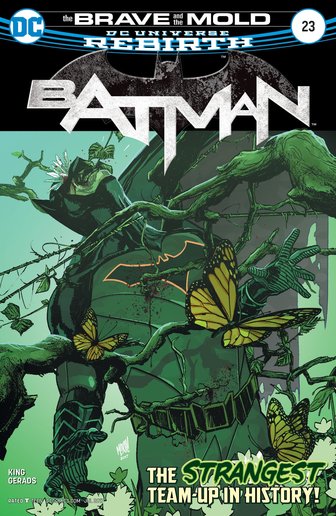 I am rapidly discovering that I should have been following Tom King’s run on Batman a lot earlier. There are 3 things that I love that compelled me to continue reading the Batman series after the conclusion of ‘The Button’, first the name of the issue was ‘The Brave and the Mold’, second the throwback subtitle ‘The Strangest Team-Up in History’ on the cover which harkened back to the playful silliness of older comics, and the fact that Swamp Thing guest stars in this issue. Swampy, puns, and nostalgia are already worth the price of admission, but what I found between the covers of this issue was spectacular. The Batman and Swamp Thing team-up to discover who killed Lloyd Bernard McGinn, the biological father of Alec Holland who became the Swamp Thing. This issue was just a delight, especially for a Swamp Thing fan like me. The first page depicts McGinn’s murder and the man bears more than a passing resemblance to Comic Creator and patron saint of Swamp Thing, Alan Moore. This may be in reference to Moore’s recent retirement from comic bookery which was announced last year, or perhaps it was just meant as a tribute to the man who made Swamp Thing the iconic character he is today, but an easter egg of that magnitude from the very first panel was enough to make me instantly fall in love with this comic. But the hits kept coming as Batman and Swampy have a conversation in the library of Wayne Manor with Alfred rushing around to clean up after the Swamp Creature, they good-cop/bad-cop the villain Kite-Man (which is a level of silly I never expected from modern DC), and trade comedic pauses in the Batcave and Batmobile. For some reason the brilliance of pairing Batman and Swamp Thing up had never occurred to me before, but for two characters defined by such unique stoic philosophies to work together makes for some unexpected humor and camaraderie that was really entertaining. But this issue really shines through its artwork and its exploration of fatherhood and loss. Coming off the poignant conclusion of ‘The Button’ storyline Batman’s determination to uncover who murdered Alec Holland’s father carries a greater weight as he admires Swamp Thing’s projected acceptance of the circular nature of life and death. Reliving the grief that made him Batman Bruce is almost relieved to see that Swamp Thing (a mysterious stoic much like himself) is handling the loss so well. Batman seems grateful and encouraged by the distraction of a new case and Swamp Thing’s philosophical explanation of life’s transition from state to state comforts him more than he lets on. That is until the final pages where Batman and Swamp Thing confront McGinn’s murderer, a mohawked villain called Headhunter. Swamp Thing’s measured posture melts away in this final confrontation and he consumes Headhunter in a mournful rage born out of regret and pain that he had kept well-hidden underneath his mossy exterior. Batman is devastated and calls out in confusion as Swamp Thing sends root, branch, and bloom through Headhunter’s insides. Batman’s sense of betrayal is twofold here: first Swamp Thing used him to get close to his father’s killer and second, Swamp Thing’s inability to cope with the grief means that the circular philosophy of life and death that he spoke of before wasn't true. Bruce was holding onto that green world logic to protect him from the pain of losing his father a second time and without that he collapses under his grief and anger. This poignant issue is brought to dazzling life by artist Mitch Gerads whose take on Swamp Thing is one of my favorites. The intricate detail and beauty through mulch that Gerads achieves is sensational. One of my favorite touches is that while Bruce and Swamp Thing talk in the library of Wayne Manor, Swamp Thing sprouts a delicate vegetable tea cup out of his hand and sips from tea he produces out of thin air. This and the gruesome beauty of his killing of Headhunter make this issue a must have for fans of Swamp Thing artwork. As Bruce continues to cope with the last words of Thomas Wayne after seeing the pain Swamp Thing goes through one can't help but wonder if the caped crusader can continue his one-man war on crime as before. Batman has come to a crossroads and I cannot wait to see what Tom King has in store for him next! Until next time, Geek On!
0 Comments
Written by Joel T. Lewis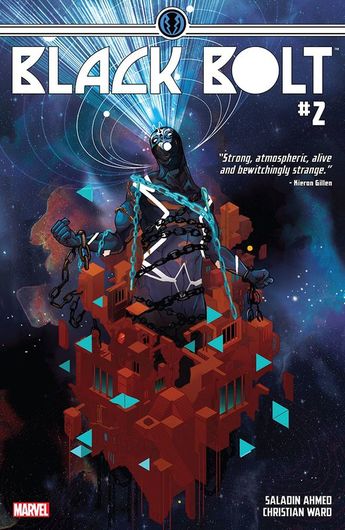 Unlikely allies coming together to escape wrongful imprisonment is hardly a new storyline. Tango and Cash, Guardians of the Galaxy, Planet Hulk, and now Black Bolt use this narrative convention to quickly build upon character development by placing central characters in a state of perpetual stress and to unite disparate characters with diverse backgrounds with the common cause of escape. The condensed version of this story that we see in Black Bolt #2 takes a lot of inspiration from the Civil War Era Hulk Story-Arc Planet Hulk (1999 Incredible Hulk 92-105) at least in terms of wrongful exile/imprisonment and Gladiatorial combat. I found that though this issue of Black Bolt retreads an all too common narrative arc, compressing all those familiar elements into a single issue made the retread almost refreshing. Instead of drawing out the ‘hero in prison’ storyline and the former enemies become allies of necessity trope over the course of a 4-5 issue arc, Saladin Ahmed’s decision to end the 2nd issue with the beginning of the escape attempt worked really well. The prison break storyline is by no means one that I’ve grown tired of but the specific similarities between Black Bolt’s story and the Planet Hulk event made me weary of a drawn out prison/gladiator narrative. With issue 2 Ahmed introduces us to several quirky inmates who plan to help Black Bolt escape. Metal Master and the female Skrull Raava join Blinky and the Crusher (known on earth as the Absorbing Man) and the group dynamic is entertaining though not particularly original. Blinky’s youthful innocence is contrasted by the wisdom of age presented by Metal Master and Raava is every bit as brusque and predictable as Star Trek’s Worf or Drax from Guardians of the Galaxy. But the character dynamic that is most fascinating and entertaining is that between Black Bolt and the Crusher. The irreverent working-class sensibilities of the B-list villain grate harshly against the decorum, silence, and tension that characterize the former King of the Inhumans. Though Black Bolt rescues and shows restraint towards his fellow inmates out of compassion and a desire to not be manipulated by the strange prison he’s trapped in, his royal arrogance and prejudice prevent him from considering himself one of the gang. The Crusher is the perfect character to call Black Bolt out on this elitist sensibility and this confrontation causes Bolt to question the violent acts he’s committed in the past. The other thing I love about pairing Bolt and Crusher up (which would be an awesome mini-series team-up) is that Crusher calls the former King ‘Wishbone’ and doubles over laughing upon hearing his full name. The rigid royal decorum that Bolt is accustomed to is shattered and called out by a very relatable Crusher. It’s also great to see a character we are meant to relate to comment on the ridiculousness of a character called Blackagar Boltagon with a tuning fork on his head who takes himself so seriously. I think the groundwork Ahmed has laid here through Black Bolt and Crusher’s alliance could potentially humanize (and the irony of humanizing an Inhuman is not lost on me) the Inhuman King in a way that comics never have before. Once again artist Christian Ward delivers a cosmic color pallet that leaps off every page and shines from the subtle shifts in facial expression to the gorgeous mayhem of Black Bolt and Raama’s sword fight. One panel in particular which showcases Ward’s exceptional flexibility is one where Crusher recounts his brawls with Thor Odinson and Jane Foster Thor. A shadowy Crusher is depicted between two brilliant sketches of both Thors. The contrast and skill Ward demonstrates is really fun to see. Though much of this issue’s plot was unoriginal Black Bolt continues to impress as artwork and story create a unique atmosphere around a conventional story. I’m fascinated by the notion that this ragtag team will be unleashed on an unknowing galaxy in issue 3 and I can’t wait! Until next time, Geek On! Written by Joel T. Lewis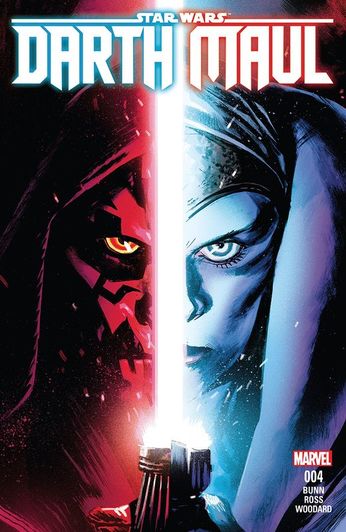 Boy am I glad I did not drop this series after last month’s disappointing issue! Honestly, this issue does all the things I criticized last month’s for getting wrong. It's almost spooky how completely Cullen Bunn’s issue 4 addressed all my concerns and made Darth Maul compelling and fun again. We get to see Darth Maul and Padawan Eldra Kaitis pop sabers and fight back to back against a horde of criminals and Bunn’s Bounty Hunter co-stars set up a great wild west ambush. Maul always burns brightest in battle, when the focused rage of his internal monologue informs the cold efficiency of his saber strikes, and this issue completely nails that construct. After Maul reluctantly frees Eldra from her bonds and returns the Jedi’s lightsaber, they proceed to cut through a dozen hunters aided briefly by Maul’s probe droids. These dazzling action panels are peppered with Maul and Eldra trading jabs about their fundamentally opposed interpretations of the Force and the history of their two orders. Though both attempt to convince each other of the merits of either side of the Force, they quickly abandon persuasion for swordplay and decide to dispatch each other once they’ve dealt with the legion of criminals that have come to hunt them. Cad Bane and company finally shine in this issue after their unexpected introduction in Darth Maul’s second installment. Pursued by a pack of hunting Trandoshans, Cad and company set up a classic western scenario where Bane challenges the leader of the pack to a blaster duel. But Bane’s duel isn’t the honorable contest of skill it appears to be as Vorheilo and Auura Sing ambush the Trandoshans and Bane never even touches his pistol. The use of Bane as the mysterious gunslinger from a space spaghetti western is so perfect and well executed that it almost makes up for the clumsy inclusion of these characters in the last two issues. This sequence is particularly well illustrated (though every panel in this issue is beautiful) perfectly capturing the aesthetic of the spaghetti western. Artist Luke Ross’s depiction of Cad Bane for instance, leaning against a rocking outcropping with his hat pulled low is instantly iconic and just dripping with spaghetti western attitude. It occurred to me while reading this issue that a big part of what made this month’s installment work for me was the separation and space between Maul and Eldra and Bane and his bounty hunters. Issue 3 was full of problems but something I didn’t pick up on until I read this issue was the claustrophobia of shoving so many characters together in small enclosed spaces. The issue seemed cacophonous and characters seemed superfluous because there was physically no room for anybody to breathe. Issue 3 begins with imprisonment and concludes with a brawl in a very small spacecraft. With so many characters confined by their proximity to each other, no wonder Bane, Sing, and Vorheilo feel tacked on for no reason. Whereas the Moon of Drazkel‘s open air and Bane and Maul splitting up gave both groups a lot of space and allowed their separate plots to develop more fully. Artist Luke Ross, like Darth Maul himself, shines in his illustrations of battles. As I mentioned earlier, his western inspired bounty hunter ambush is exceptional but seeing his dynamic lightsaber battle sketches leap off the page is really compelling and turning every page is exciting. Also, colorist Nolan Woodard really informs the atmosphere of the Moon of Drazkel through his work with shadow and especially with how he colors the sky. The perpetual twilight Woodard creates with a cool magenta skyline gives a great other-worldly glow to every panel. If this issue hasn’t necessarily restored my faith in Cullen Bunn’s Darth Maul, it definitely has treated my wounds enough to make me excited for the fifth and final chapter of the series coming out next month. Let’s hope that Darth Maul and Eldra Kaitis’s final battle will stick the landing for a mini-series that has yo-yoed between middling and exceptional. Until next time, Geek On! Written by Joel T. Lewis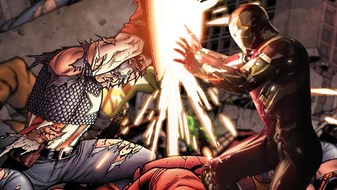 How do you take a community that takes so much pride in its members knowledge of obscure and universe spanning trivia and make it more alienating to newcomers? A strong argument could be made that large Comic Book Events do just that. Typically, the implications of massive multi-series story arcs like Flashpoint, Infinite Crisis, Civil War, or the more recent Secret Empire are major universe/continuity shake-ups. By definition, shaking up a narrative as multifaceted as a comic book universe doesn’t encourage newcomers to jump on board, especially when the shake-up can span anywhere from 10-20 comic book titles. The problems that arise, even for veteran comic book readers are several and varied. The cost of keeping up with every issue of a comic book event alone is enough to discourage even hard core fans from following along. For example, the last Marvel event, Civil War II spanned just over 40 titles across the Marvel Universe with each series contributing 2-5 issues a piece. At $3.99 a pop (and usually large event specific titles like the 7 issues of Civil War II jump to $4.99) the financial burden of following every aspect of that storyline is staggering! Even if you can swing the cover price for all those series for the duration of the event, keeping track of the timeline of events in a massive event can be tedious and frustrating. Even within the Marvel Unlimited Subscription App I’ve had multiple suggested reading orders for the same comic book event, which is infinitely frustrating because you constantly feel like you’re back tracking. Also, as the comic book industry has discovered how profitable these large events can be they are happening more and more frequently. So it doesn’t matter if you’ve finally gotten a grasp on the new baseline for a universe following Civil War II for example, because Secret Empire has started and shook up the continuity again. The looming possibility of another cataclysmic event doesn’t inspire any confidence in the integrity of a character or team’s make up because there’s no guarantee that they’ll be given the space to grow given the developments of the previous event. So imagine trying to pick up comics for the first time in the midst of a major event. Suddenly you can’t just buy the latest issue of Captain Marvel and pick up the story, you have to buy the 8 issues before that, plus all the Marvel titles that tie in and hope you pull enough of the threads together to fill in the gaps of the issues you missed. Now you’re broke, lost, and what was supposed to be fun has now become a chore. So, as I have faced down the daunting notion of the Comic Book Event myself I thought I would write up a guide for how to navigate what has become a big part of modern comic bookery. Reading an Event that has Already Occurred 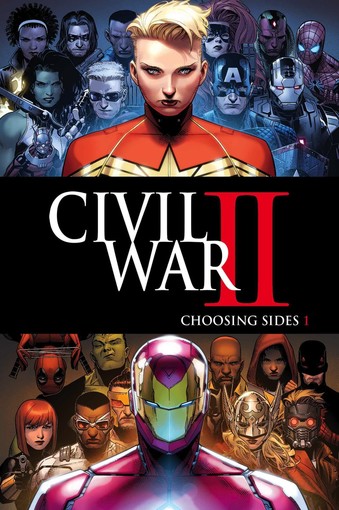 Make a list, shop for trades, and don’t be afraid to be selective about what you read. Approaching an event that has already been released in full puts you in the best possible position to track down every aspect of the storyline, or pick and choose from trade paperbacks. The first step is finding a complete reading list for the event you want to read. Unfortunately, the DC and Marvel Websites are not as comprehensive or accessible as is necessary to compile a suggested reading list. If you have a Marvel Unlimited Subscription, the lists and suggested reading orders that you have access to through the browse feature of your app or online, while a bit nebulous, are very comprehensive. I research different comic events through ComicVine.com’s search function. Be sure when using this search that you click on the 'Story Arc' results in order to see all the issues included in the event. Also, to avoid spoilers, when you reach the story arc page, scroll all the way to the bottom to the Issues section. This will give you a pretty thorough list of all the titles that tie-in to the event in chronological order and show you every issue’s cover art so that they’re easy to track down individually. Now, when deciding where to spend your time within a given story arc there are a couple of different options: The quickest and cheapest way to get the general idea of a big story arc is to read the title series. There are 110 individual tie-in issues that make up the Marvel Civil War Event, but there are only 7 issues of the Civil War title series that give you the basic plot points without a huge investment of time or money. These are pretty easy to track down in Trade format and are a great way to absorb the bullet points of an event without going blind from reading. Another option is to trace characters you’re already invested in throughout the event. Picking up all of the Wolverine: Civil War issues either individually or in trade for example, gives you a focused and self-contained storyline that occurs within the scope of the larger event but without the noise or confusion inherent in following so many storylines all at once. Also, don’t let the stress of a universe spanning event keep you from continuing a series you like. I discovered recently that the Marvel titles I was already following (Power Man and Iron Fist, Totally Awesome Hulk, and Mighty Thor) which all tied in with the Civil War II event (which, to be honest, I wasn’t that interested in) were self-contained and interesting enough that their involvement in the larger narrative didn't ruin or upset what I enjoyed about those titles. In fact, the issues of those titles that tied-in with the Civil War II event were really interesting and I was glad to have read them. Unless you have the funds, time, and interest, don’t feel like you must read everything! There is no shame in skipping a stretch of the arc if you have no interest in the characters that star in that section of the story. If you have no interest in Suicide Squad, Heroes for Hire, or Ghost Rider, skipping those threads isn’t going to cripple the impact of the larger narrative, and if there happens to be a reference to the events of those arcs that you skipped, you can always back-track to fill in the gaps with an issue or two. Reading an Event as it Comes Out 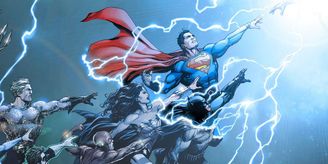 Budget early and strictly, branch out from the Main Event title slowly, and don't be afraid to drop a title that stops interesting you. If you are dead set on following a Large Comic Event as it comes out your budget is key. Again, don't feel obligated to buy every tie-in title. Focus on the main series title first and build out slowly in the direction of characters you are already invested in. Look for creative teams you are familiar with from previous series or cover art that grabs you. Also, at the end of most modern tie-in comics there will be suggestions for what series to pick up next. Use these ads to determine how far down the rabbit hole you'd like to tumble. Also, don't be afraid to abandon a tie-in series if you don't like where it's going! Too often I find myself limping along with a series I'm not that invested in just for the sake of completing the event. Don't do that to yourself. With Denver Comic Con rapidly approaching and comic book events like DC’s Rebirth and Marvel’s Secret Empire going right now, it’s a great time to look into starting a Comic Book Event. I hope this article made the process seem a bit less daunting and I would love to hear if you have any strategies that might help me the next time I dive into a new one! Until next time, Geek On! Written by Joel T. Lewis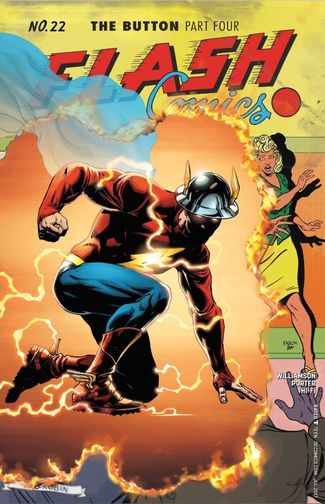 I am at a considerable disadvantage when it comes to the history of the Flash. I was only aware of one man who wore the red and yellow costume as I grew up and that was Wally West. It was just a name I filed away under 'Flash' and I never really thought about the character again. So the brief reappearance of the wing-helmeted first Flash (Jay Garrett) at a pivotal moment in issue 22, while visually spectacular, did not resonate with me that way it might have with the die-hard Flash Fanatics. That being said, this is the second appearance of a past Flash in the larger Rebirth storyline and that tells something about the importance of the Flash and his history to the larger development of the Rebirth Event. I believe one of the big lessons DC learned from the divisive Flashpoint story-arc was that Barry Allen is a great character to frame massive comic events around. The huge Flash-specific elements that have already been revealed so far in the Rebirth story seem to point to DC capitalizing on his charm and relatability once again as a key component of the Rebirth narrative. As a conclusion for the 'Button' arc, issue 22 doesn’t really deliver on the massive hype anticipated by audiences desperate for some concrete connections between the DC Universe and the Watchmen Universe. Joshua Williamson does treat us to a final panel confirmation that the 'God' that murdered Eobard Thawne is in fact Dr. Manhattan, but that revelation is slightly undercut by how obvious it was. Again, where this mini arc has shone most brightly has been in its exploration and resolution of loose threads from the Flashpoint Event, and Flash 22 was no exception. Unable to warn Reverse Flash of his impending doom, Batman and Flash seem doomed themselves as the Cosmic Treadmill, their only stability as they hurtle through space and time, disintegrates underneath them. Tumbling out of control and almost out of existence, Barry and Bruce are saved by Jay Garrett, who’s vintage costume is brought to dazzling life by artist Howard Porter. In an arc that has been characterized by brilliant cosmic panels, Garrett’s return is spectacular and the throwback hero steals every panel he’s in. Tragically, Garrett suffers the same fate as Thomas Wayne before him and is erased before he can explain the bizarre circumstances of his appearance leaving Bruce and Barry back where this topsy-turvy journey began. As Bruce and Barry ponder the death of Thawne, Thomas Wayne, and the mysterious former Flash, they ruminate over their shared trauma of loss and plan their next steps. Our final glimpse of Batman shows him contemplating his father’s words as the Gotham City skyline lights up with the Bat-Signal, and for the first time, he hesitates to answer the call. Issue 22 concludes with a mind-blowing teaser for the next installment in the larger Rebirth narrative as the Comedian’s button, set adrift in space by Dr. Manhattan, is eclipsed by the iconic symbol of the Man of Steel. Superman: Doomsday Clock is scheduled for release in November, and I am very curious to follow along as the Rebirth story continues to unfold. 'The Button' arc’s most poignant implications, at least for me, concern the future of Batman. By freeing him from the guilt and obligation of vigilantism for the sake of his parents, Thomas Wayne has challenged the very foundation of what Bruce has dedicated his life to. Batman has never had to consider what would make him happy because Batman's mission was so imperative. Thomas Wayne dismantles that logic by begging his son to find a way to be happy. This request leads Batman and his fans to ponder the question: What could make Bruce Wayne happy? Until next time, Geek On! Written by Zeke Perez Jr.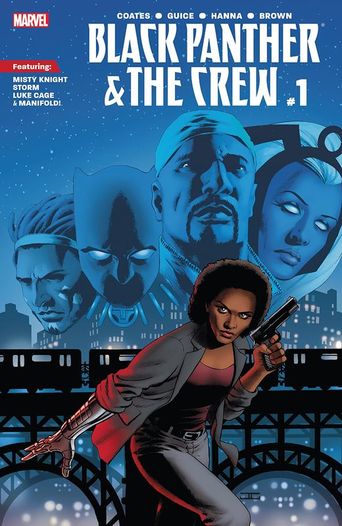 Both Marvel and DC have provided us with countless outstanding superhero teams over the years. With Black Panther, Misty Knight, Luke Cage, Storm, and Manifold, the crew in Black Panther & The Crew certainly packs a punch. The roster alone ranks among the most intriguing team-ups in comic lore. In addition to the super-team, Ta-Nehisi Coates puts forth a riveting and important story, as the team investigates the death of a Harlem activist and his role in assembling a team of superheros in the 1950's. The story also delves into race relations and the ramifications of police brutality, hitting close to home in American society today. The series reunites Coates with World of Wakanda partner Yona Harvey. Coates has given voice to activism, Civil Rights, race relations, and the Black experience in his previous books, memoirs, articles, and speeches, as well as in his previous work in comics, including the aforementioned World of Wakanda and his current Black Panther run that began in 2016. Whereas World of Wakanda and Black Panther were both set in Wakanda, The Crew is unique as it is set in the United States and deals with socioeconomic and political issues exclusive to the country. Black Panther & The Crew follows in the footsteps of the 2003 series The Crew, which focused on gentrification and poverty. Issues one and two set the stage for the conflict, weaving between the past and present. The second even briefly ventures back to Little Mogadishu, the setting for the original The Crew series. The story moves at a glacial pace in introducing the super team, focusing solely on Misty Knight and Storm in the first two issues, with Black Panther making his debut at the very end of the second. Editor Wil Moss called for patience in the letters page of the first issue as the crew comes together. Unfortunately, after just those two issues it was announced that the series was cancelled, with poor sales being cited as the main reason. The news got me thinking about a few things. First, what exactly does 'poor sales' mean in the comic world? How low do sales have to be before the plug is pulled on a series? Second, if The Crew did suffer from poor sales, why weren’t people buying it? The great folks over at Comichron.com keep monthly sales numbers using the 'Final Orders' numbers from comic book distributors who serve comic book shops nationwide (it should be noted that this doesn’t account for digital or international sales). Using their data, I found that Black Panther & The Crew #1 sold 35,604 units. That ranked The Crew 57th in comics sold in the month of April. By comparison, the top three sellers were Secret Empire (162,718), Batman #21 (130,216), and X-Men Gold #1 (114,332). 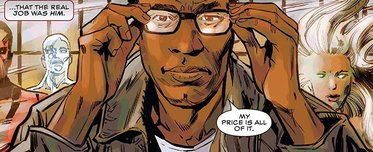 The Crew’s figures were good for the most sales among Black Panther properties, beating out Black Panther (30,509) and World of Wakanda (only 14,547). Among other 'big name' titles, it beat sales for Marvel’s Iron Fist #2 (28,649) and Hulk #5 (22,644), and the hyped-up Archie comic Riverdale #1 (15,781). At over 35,000 copies sold, The Crew wasn’t at the top of the charts, but by no means was it a failure. In fact, it performed better than a variety of Marvel properties. So why was it pulled early? Some takes from the media have suggested that it was related to the ongoing discussion of diversity in comics. It could be that the month-to-month market is crowded for Black Panther right now with three titles out. While The Crew outpaced Black Panther and World of Wakanda in April, Marvel may have decided to stick with the two established series. Or it may have just been the case that many comics face a short lifespan. That’s sometimes the nature of the business. Whatever spurred the cancellation, it is unfortunate for a number of reasons. First and foremost, The Crew is covering some very timely and extremely important issues, including police brutality and race relations. It’s always good to have another voice lent to the heavy problems in the world right now. The cancellation is also rough because it forces the tempo of the comic. The team will now have much less liberty to unfold the story slowly as originally planned. While Coates and the team will still get a few more issues to wrap up the story, it’s a shame that they’ll have to share a marathon’s worth of a story in a sprint’s pace. Nonetheless, Coates’ and Harvey’s venture truly deserves support. As far as short runs go, it would be hard to find such a compelling, powerful and timely story with an all-star cast of characters elsewhere. The final four issues should be a whirlwind worth checking out. Black Panther & The Crew #3 goes on sale Wednesday, June 14th. Update: In the time after this article was written, Marvel quietly cancelled the other Black Panther spinoff, World of Wakanda. Written by Joel T. Lewis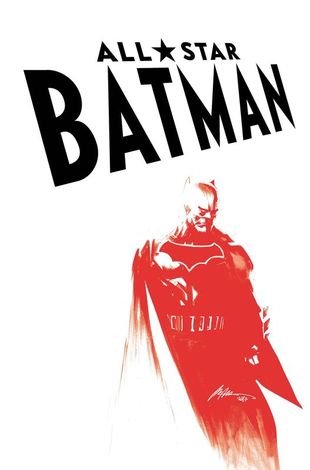 A father-son narrative, an epic revelation about our favorite Bat-Butler, and real honest-to-goodness Pirates? Scott Snyder is back in a major way with issue 10 of All-Star Batman. It’s not often that I’ve read a Batman story narrated by Alfred, and I have to say his is one of the most fascinating perspectives in the microcosm of the Bat-Family. What compels a man to support a willful vigilante year after year, how does he cope with the carnage his son in all but name sustains on a nightly basis, and what perspective does the first member of the Bat-Family bring to the Batman narrative? Well, Snyder’s Alfred takes it all in stride and contributes the same levity and fun that has made me love the All-Star Batman series’ portrayal of Batman. We begin issue 10 by following Batman and Alfred as they pursue Hush on the streets of Miami. Hush, once again impersonating Bruce Wayne, has attempted to infiltrate the criminal underground treasure trove known as Fort Dexter. Hush planned to intercept a mysterious device known only as the Genesis Engine as it arrived at the legendary storage facility of pirates past. A location with a long history associated with legendary thieves, the modern Fort Dexter is managed by the direct descendants of actual pirates. Planning to locate and secure the Genesis Engine himself, Bruce arranges to meet with the scions of Black Caesar, John Rackum, El Diabolito, and Blackbeard himself. In an ironic twist, Bruce is mistaken for Hush by the Pirate descendants and as he wades his way through a storm of bullets he discovers the leader, Thatch, has been murdered with ruthless efficiency. Interspersed throughout this present storyline, Snyder guides us through a misleading set of flashbacks that appear to show a young Bruce Wayne dodging a set of British constables over the rooftops of London. Leaving behind a unique graffiti tag, the masked youth leads the Bobbies on a merry chase before being laid out on the top of a double decker bus. As we reach the final pages of the issue we discover that the wound inflicted on Thatch in the present storyline is identical to the graffiti left behind by the man we were led to believe was a young Bruce Wayne. But it's not Bruce Wayne. The anarchist artist is actually Alfred Pennyworth. In recent weeks it seems that the guiding philosophy with both Batman titles (All-Star and Rebirth respectably) has been to hammer home the theme of fatherhood. I often forget that Alfred is Bruce’s adopted father and that’s understandable given that for the most part the faithful butler seems almost a part of the furniture of Wayne Manor and the Batcave. Pennyworth is always within earshot and primed to cater to the eccentric billionaire and his unusual nocturnal habits. But, this is the first time I’ve seen Alfred refer to Bruce so pointedly as 'my son.' The intimacy, concern, and pride that Snyder conveys about the father/son dynamic between butler and Batman through Alfred’s narration fills in a void about their relationship I had never noticed before. Snyder gives Alfred some of the most poignant lines the butler has ever uttered when describing his son, 'Over the years, my son has developed a bit of a flair for the theatrical. I like to think he gets it from me. But really, if I’m being honest with myself...it’s something all his own.' The honesty and levity of these words drive at the heart of paternal pride and self-awareness so precisely that they could be lifted out of the Bat narrative and applied to any father-son relationship. Getting to see Alfred beam with pride over his son’s style and dramatic nature was something I hadn’t experienced before and it adds so much to the intimacy of their relationship. Alfred continues with an honesty that only comes from the unconditional love of a father for a son, 'The world knows my son as a hero. And he is. Never stopping...even when I beg him to. He’s an absurd human being, is the truth...bloody absurd. And I love him for it.' Snyder has really reshaped how I think about Bruce and Alfred’s relationship, and I cannot wait to learn more about the butler’s past anarchy. Also, artist Rafael Albuquerque does an outstanding job with this issue finding a unique line somewhere between the techno-noir style of Francesco Francavilla and the stark cutting sketches of Jock. I don’t believe I’ve ever seen a cooler interpretation of the Batmobile than the one Albuquerque brings to life in this issue. I am definitely looking forward to seeing the powerhouse combination of Snyder and Albuquerque continue to produce spectacular comics as this arc continues. Until next time, Geek On! Written by Joel T. Lewis How does the greatest Moon Knight Story end? How does the most anticipated clash between Priest and Deity conclude? How does Marc Spector break free of the manipulative shackles of his vengeful benefactor? I can tell you it doesn't end with a crash, not with a dizzying crescendo. The pages that lie beneath that beautiful cacophonous cover don't show a cataclysmic battle with legions of Spectors, Lockleys, and Grants tumbling over each other in a battle as much against self as it is against Khonshu. And to be perfectly honest, therein lies the brilliance of Lemire’s finale. As Marc makes his way back through the halls of his hellish asylum, he flashes between the present reunion between himself, the jackal-headed hospital attendants Bobby and Billy, and the sinister Dr. Ammut and his cold painful journey to the temple of Khonshu many years ago. As Marc succumbs to the chemically-induced paralysis imposed on him by the bumbling Jackals, Khonshu carries his body in the past to the foot of his own statue, explaining the fluidity of time and space in the Othervoid. After being subjected to a nasty shock courtesy of Dr. Ammut, Marc awakens back in Egypt as he did so many years ago and Jeff Lemire lifts Marc’s words straight from Doug Moench’s very first issue of Moon Knight back in 1980. This callback resonated with Lemire’s characteristic respect for the origins of Moon Knight and it was incredible to read those words again. The weight of Lemire’s retelling and the freshness of Smallwood’s art really breathed new life into the fantastic dialogue Moench wrote almost 40 years ago. After Marc takes up the mantle of the Moon Knight, he breaks free of his restraints and quickly dispatches Ammut and her cronies one last time before reaching the roof to confront Khonshu. Khonshu can no longer pit Marc Spector against the separate aspects of himself. So he attacks him with shades of past enemies instead; flickering shadows of werewolves, stained-glass femme fatales, armor-plated politicians, twisted mirror images, and cruel mercenaries. Khonshu twists and warps reality as Bushman, Black Spectre, Stained Glass Scarlett, and Midnight Man attack Marc from every angle. Marc’s surroundings shift from rooftop, to moonscape, to New Egypt as Khonshu bombards him with figures from his past. Instead of folding under the fear these specters are meant to inspire, Marc faces down his God and fights in a way we've never seen before. As he cuts through the false forms of his old rogue’s gallery, his hands tighten in a grip around the now fragile looking bird skull of Khonshu’s Othervoid form. In this moment he is not merely Spector. He is Marc Spector, he is Steven Grant, and he is Jake Lockley. They are one. They are Moon Knight. And they are enough. Powerful and united Moon Knight emerges victorious over the infectious madness Khonshu inflicted on them. The four panels that Smallwood uses to illustrate Moon Knight’s final moment of self-awareness are focused, flawless, and spectacular. The quiet calm of this series’ conclusion speaks to how Moon Knight has grown throughout the course of this run. It is through measured collaboration with all aspects of his personality that Moon Knight finds his strength and it is his self-acceptance that allows him to overcome the fear Khonshu has employed to manipulate him over the years. How do you say goodbye to a series as important, thoughtful, groundbreaking, and perfect as this one has been? I’m not sure I know how dear readers. What Lemire, Smallwood, and Bellaire were able to bring to this chronically underrated superhero is nothing short of poetry. Their understanding of the character transcends and enhances all that came before, their vision for the psyche of this hero has been thoughtful, kind, and honest, and their synchronicity of vision with every panel, letter, and splash of color is among the highest order of art I’ve had the pleasure to experience. This is the first comic book series I’ve ever collected every month as it’s come out and it was a pleasure to follow. I’d like to thank Greg Smallwood for capturing the pain of a man constantly running from his fear of madness. I’d like to thank Jordie Bellaire for giving a hero clad in white so much brilliance. Finally, I’d like to thank Jeff Lemire for treating my favorite hero the way I’d like to think I would, like a dear old friend. Before closing the door on this outstanding series of Moon Knight I wanted to share something pretty special that I discovered on the second to last page of issue 14. I wrote a letter to the creative team of Moon Knight. I’ve never done that before, and when I sent it I figured that because I had waited so long to send anything I was too late to have it published in the final issue. Turns out I wasn’t too late and the letter I wrote is on the second page of the 'Moonie Missives' section of the last issue of the series. Trying to describe what it feels like to fall in love with a character as obscure as Moon Knight, to luck into reading the most important of his stories month-to-month, and then to have my name printed in the final issue is impossible. Comics do that to you. They inspire you, capture you, and make you part of the adventure in a way few works of art can. Until next time, Geek On! Written by Joel T. Lewis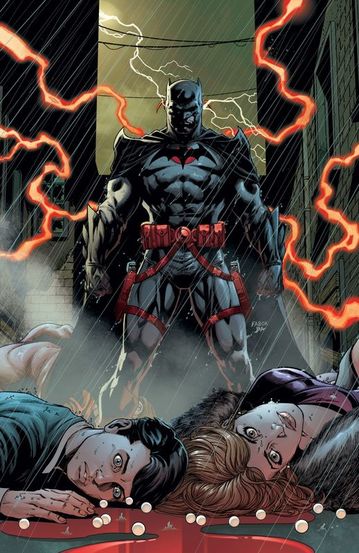 I’m rapidly discovering that the Button storyline woven between the Flash and Batman titles is more about the ramifications of the Flashpoint event and giving Thomas Wayne Batman closure than it is about the discovery of the Comedian’s Button in the Batcave. At least in the 3 issues that have been published, we have chased the mysterious button through space and time via the Cosmic Treadmill and reentered the world of Flashpoint, but have yet to encounter any other elements of the Watchmen Universe. Though this is a bit of a disappointment given the title of the arc, I would not trade the closure we get from Thomas Wayne in these issues for anything in the world. For those of you who may not know, in the Flashpoint Universe that Barry Allen created by going back in time to save his mother, Thomas and Martha Wayne are not murdered in a dark alley in Gotham City that cold night many years ago, Bruce is. As a result of this bizarre twist, Bruce’s father becomes an embittered alcoholic and vicious vigilante, terrorizing the criminal underground of Gotham as a pistol-toting Dark Knight. Martha Wayne, unable to cope with the horror of having witnessing her child murdered in cold blood, becomes the Flashpoint Universe Joker. Though the Flashpoint event is pretty contentious among comic book fans (but to be honest, what isn’t?) the inverted Batman is fascinating, and in this issue we get to see Bruce and Thomas Wayne meet. The two Batmen don’t have much time to reconnect as the arrival of Bruce and Barry is quickly followed by soldiers of Atlantis and New Themyscira sent to kill Thomas Wayne. As Barry rushes to reassemble the shattered Cosmic Treadmill, Bruce and his father prepare for battle, but before Thomas can unload a clip from his signature Bat-Pistols Bruce Batarangs the gun out of his hand. I love this panel so much. It’s a great testament to the power of Bruce’s conviction but also to Thomas’ immediate respect for his son’s non-lethal philosophy. It’s a small moment in a big issue but it conveys how well Joshua Williamson and Tom King understand both Batmen. As the Batmen duke it out with Aquaman and Wonder Woman’s soldiers and Barry rebuilds the Cosmic Treadmill, the fabric of the Flashpoint reality unravels in the background. The silhouetted panels depicting Thomas and Bruce Wayne are especially well executed by artist Jason Fabok. The ambiguity you feel seeing just the outline of a Batman shows father and son to be two of a kind as they dispatch the attackers. Finishing the reconstruction of the Cosmic Treadmill as Bruce lands the final punch, Flash tells the Batmen to hurry as the treadmill seems to be about to leave without Barry powering it. Thomas and his son have just enough time for one of the sweetest heart-to-hearts in Bat-history. ‘Father...your letter...it was the greatest gift anyone’s ever given to me. After I read it...I knew I’d never get a chance to respond, but if I did, there was one thing I wanted to tell you above anything else...You’re a grandfather. I have a son.’ Bruce pleads with his Father to come with them but Thomas pushes his son into the flashing light of the rapidly departing treadmill deciding to stay in his own reality. As Flash and Bruce fade into the stream of time and space Thomas tells Bruce, ‘You’re the greatest gift this life has ever given me. And there is more I should have shared in that letter, so listen to me. Don’t be Batman. Find happiness. Please. You don’t have to do this. Don’t do it for me. Don’t do it for your mother. Be a father to your son in a way I never could be for you. Let the Batman die with me.’ Bruce calls out to his father as he and the Flash wink out of the Flashpoint, ‘We can save you!’ Bruce and Barry hurtle to a destination unknown and Reverse Flash appears behind them in the wake of the Cosmic Treadmill. As he passes them by, the two heroes realize that these are the moments just before Reverse Flash met his end and was sent back to the Batcave. Reverse Flash still has the button and Batman and Flash rush to follow him towards the god that destroyed him. Now if there are dry eyes among any of my fellow bat-fans following the heartfelt speech Thomas Wayne gives to his son as he hurtles away through space and time I’m not sure even Victor Fries’ has a heart as cold as yours. Though I began reading the Batman Rebirth title series just for this four-issue storyline, I’m not sure I can live without following Bruce’s contemplation of his father’s final words. In a way Bruce has been released from a lifetime’s worth of guilt-fueled rage and his obsession with vengeance. How Batman will continue after this catharsis will be very interesting to discover. Also the finale of the Button storyline is rapidly approaching and I can’t wait to read that either! Until next time, Geek On! Written by Joel T. Lewis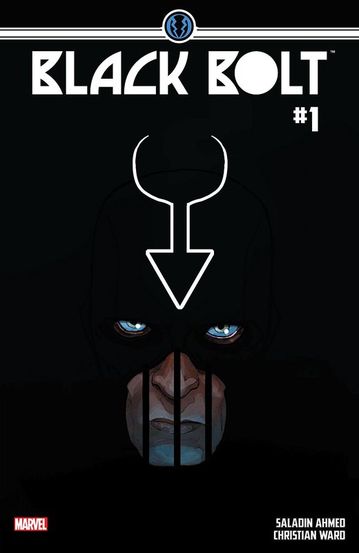 It is immensely difficult for me to engage with superhero team comics. The Justice League, Avengers, X-Men, and Suicide Squad all struck me as either too massive or too established to engage as fully as I would need to in order to get up to speed. Too many character histories with too many idiosyncrasies and continuity shake-ups would overwhelm my completionist brain as I felt the pressure of those back catalogues. That’s not to say I refuse to engage in those larger group narratives across the board, I just skirt the edges of those series in order to keep myself sane and socially engaged. That being the case, there is one superhero team in particular that I have had next to no interest in until very recently: The Inhumans. This moon-based kingdom of Kree manipulated humanoids and their bizarre history of royal family politics and Terrigen mist disasters seemed to be the most inaccessible corner of comic lore. The similar themes of species distinction and prejudice that the Inhumans shared with the X-Men also contributed to my lack of interest. I got along pretty well avoiding that section of the Marvel Universe as their impact seemed to be pretty well contained in their own title series and their interactions with other teams like the Avengers or the X-Men. But recently, I was fascinated by, you guessed it, some pretty spectacular cover art of a character I had never heard of: The Inhumans’ own Karnak. I devoured the 5-issue mini-series focused on the revamped characterization of Karnak and suddenly the Inhumans began to fascinate me. Lucky for me, with the recent conclusion of the Inhumans vs. X-Men event the Inhumans were slated for a new series entitled Royals and for the first time ever a solo series centered on the leader of the Inhumans, Black Bolt. The King of the Inhumans, Black Bolt is an interesting typically stoic figure who seldom speaks because his voice is powerful enough to bring a city crumbling down to its foundations. He’s got a pretty wicked black suit with lightning bolt accents and a tuning fork antenna on his head which allows him to focus his powers to increase his strength and speed. In the brief glimpses I had seen of the Inhumans before I had expressed any interest in the team, Black Bolt always stood out visually and his power set fascinated me. So naturally I leapt at the opportunity to read a Black Bolt solo title. Following the events of Inhumans vs. X-Men it is discovered that the brother of Black Bolt, Maximus the Mad has been impersonating the King while his brother languishes in a prison meant for him. We catch up with Black Bolt in this bizarre space prison in issue 1. While this may seem to be a bit of a strange midpoint to jump into the Inhumans world, issue one was low impact and self-contained enough that it was a great jumping on point. The King of the Inhumans doesn’t know where he is, who he is, or what he’s been imprisoned for and as we follow him day to day in his incarceration he is tormented by an ear-shattering voice that causes him great pain. As the days pass Black Bolt remembers piece by piece the circumstances of his capture and the Inhuman he has to blame, his brother Maximus. Now, the Inhuman Royal is unable to shout his way out of confinement thanks to probably the coolest looking muzzle of all time. But he slowly tests the strength of his bonds and manages to break free to explore the vast space prison that he finds himself in. He quickly discovers that he is not alone in this prison and witnesses firsthand the cruelty and depth of his captor’s torture methods. Bolt desperately tries to save a child from a torture device in the bowels of the prison but can only hold her charred corpse when he discovers he is too late. Unable to investigate further, Bolt is interrupted by a de-powered Absorbing Man (Carl “Crusher” Creel) who quickly challenges the silent newcomer to a fight. Although Bolt is more than capable of dispatching the arrogant inmate, the Absorbing Man manages to damage his muzzle with a lucky punch. Bolt quickly finishes with Creel and tracks down the source of the cruel accusing voice that has tormented him throughout his imprisonment. This tormentor is a terrifying aberration who does not balk when Bolt dramatically removes his muzzle to whisper what should have been a deadly word, 'Stop.' Black Bolt quickly discovers that his powers have been stripped from him right before his vocal tormentor burns him to a crisp. Bolt awakens on the final page back in his cell to discover that the child he attempted to save has been reborn as well and we discover that the prison is a bit stranger than we once thought. Author Saladin Ahmed makes a triumphant debut into the world of comics with this issue and artist Christian Ward is no slouch either. Mysterious, compelling, and visually breathtaking the combination of Ward and Ahmed has got its hooks in me for as many issues as this title runs. The techno-surreal setting of a space prison is brought to colorful life by Ward’s wonderful play with scale and unique panel design and Black Bolt has never looked cooler. In fact, seeing the page where Bolt breaks free from his chains is what sold me on the comic in the first place. I cannot wait for next month’s issue of Black Bolt! Until next time, Geek On! |
Archives
May 2024
|
|
© 2012-2025, Nerds That Geek LLC.
All Rights Reserved. |
uWeb Hosting by FatCow
